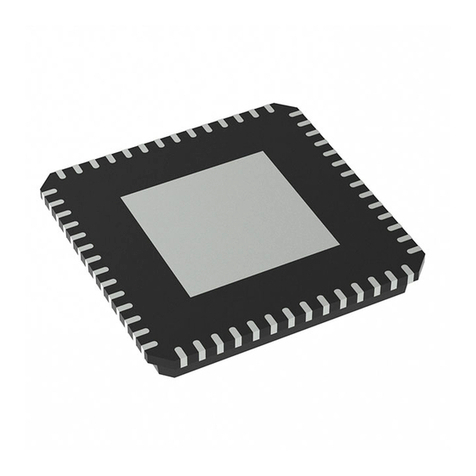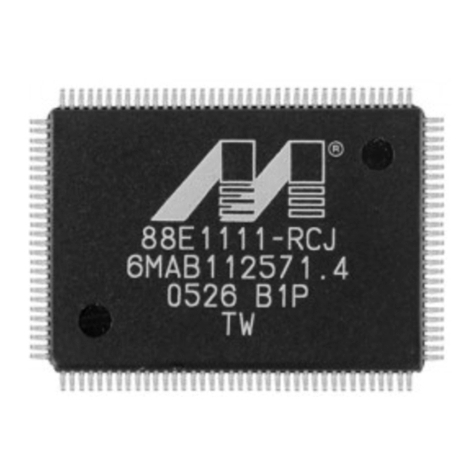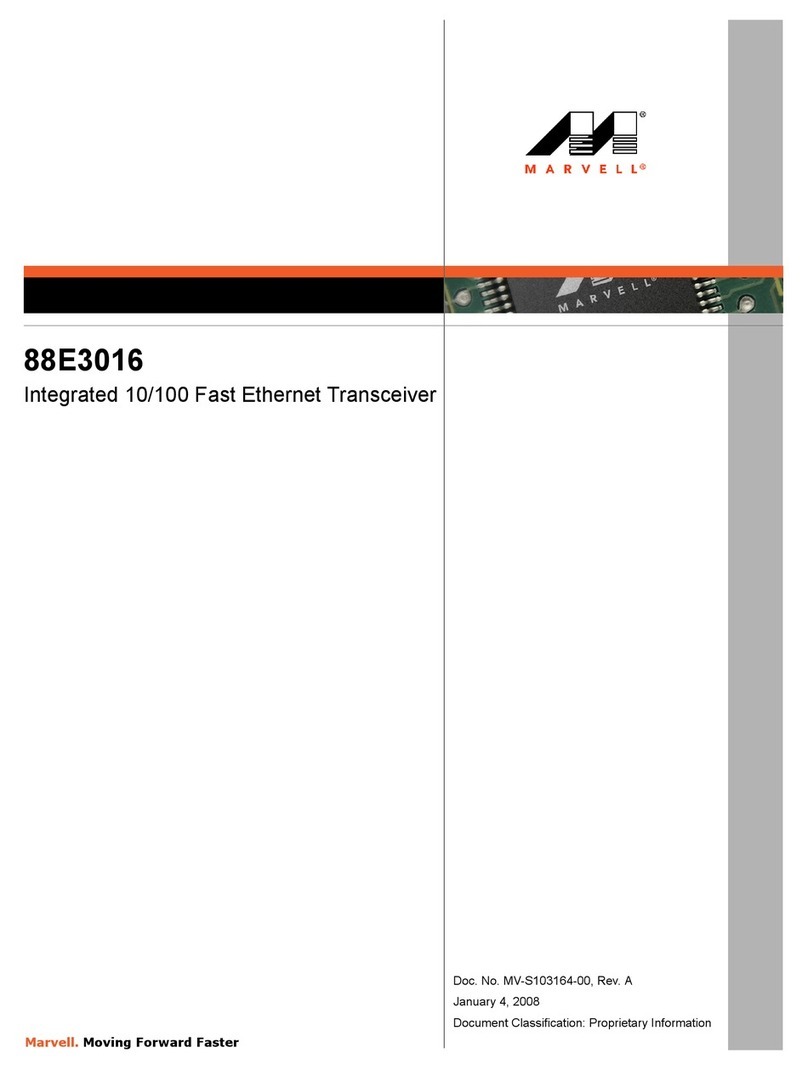
88E1111 Product Brief
Integrated 10/100/1000 Ultra Gigabit Ethernet Transceiver
Copyright © 2009 Marvell Doc. No. MV-S105540-00, Rev. --
March 4, 2009, Advance Document Classification: Proprietary Information Page 3
OVERVIEW
The Alaska®Ultra 88E1111 Gigabit Ethernet Trans-
ceiver is a physical layer device for Ethernet
1000BASE-T, 100BASE-TX, and 10BASE-T applica-
tions. It is manufactured using standard digital CMOS
process and contains all the active circuitry required to
implement the physical layer functions to transmit and
receive data on standard CAT 5 unshielded twisted pair.
The 88E1111 device incorporates the Marvell Virtual
Cable Tester®(VCT™) feature, which uses Time
Domain Reflectometry (TDR) technology for the remote
identification of potential cable malfunctions, thus
reducing equipment returns and service calls. Using
VCT, the Alaska 88E1111 device detects and reports
potential cabling issues such as pair swaps, pair polar-
ity and excessive pair skew. The device will also detect
cable opens, shorts or any impedance mismatch in the
cable and report accurately within one meter the dis-
tance to the fault.
The 88E1111 device supports the Gigabit Media Inde-
pendent Interface (GMII), Reduced GMII (RGMII),
Serial Gigabit Media Independent Interface (SGMII),
the Ten-Bit Interface (TBI), and Reduced TBI (RTBI) for
direct connection to a MAC/Switch port.
The 88E1111 device incorporates an optional 1.25 GHz
SERDES (Serializer/Deserializer). The serial interface
may be connected directly to a fiber-optic transceiver
for 1000BASE-T/1000BASE-X media conversion appli-
cations. Additionally, the 88E1111 device may be used
to implement 1000BASE-T Gigabit Interface Converter
(GBIC) or Small Form Factor Pluggable (SFP) modules.
The 88E1111 device uses advanced mixed-signal pro-
cessing to perform equalization, echo and crosstalk
cancellation, data recovery, and error correction at a
gigabit per second data rate. The device achieves
robust performance in noisy environments with very low
power dissipation.
The 88E1111 device is offered in three different pack-
age options including a 117-Pin TFBGA, a 96-pin BCC
featuring a body size of only 9 x 9 mm, and a 128 PQFP
package.
FEATURES
•10/100/1000BASE-T IEEE 802.3 compliant
•Supports GMII, TBI, reduced pin count GMII
(RGMII), reduced pin count TBI (RTBI), and serial
GMII (SGMII) interfaces
•Integrated 1.25 GHz SERDES for 1000BASE-X
fiber applications
•Four RGMII timing modes
•Energy Detect and Energy Detect+ low power
modes
•Three loopback modes for diagnostics
•“Downshift” mode for two-pair cable installations
•Fully integrated digital adaptive equalizers, echo
cancellers, and crosstalk cancellers
•Advanced digital baseline wander correction
•Automatic MDI/MDIX crossover at all speeds of
operation
•Automatic polarity correction
•IEEE 802.3u compliant Auto-Negotiation
•Software programmable LED modes including LED
testing
•Automatic detection of fiber or copper operation
•Supports IEEE 1149.1 JTAG
•Two-Wire Serial Interface (TWSI) and MDC/MDIO
•CRC checker, packet counter
•Packet generation
•Virtual Cable Tester (VCT)
•Auto-Calibration for MAC Interface outputs
•Requires only two supplies: 2.5V and 1.0V (with
1.2V option for the 1.0V supply)
•I/Os are 3.3V tolerant
•Low power dissipation Pave = 0.75W
•117-Pin TFBGA, 96-Pin BCC, and 128 PQFP
package options
•117-Pin TFBGA and 96-Pin BCC packages avail-
able in Commercial or Industrial grade
•RoHS 6/6 compliant packages available






























